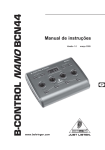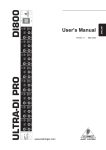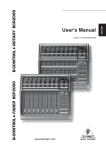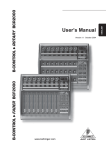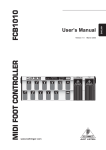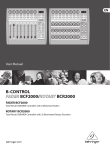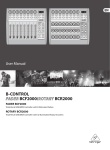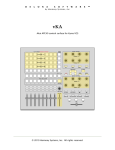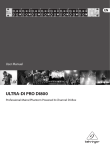Download Behringer BCN44 User`s manual
Transcript
B-CONTROL NANO BCN44 Users manual Version 1.0 March 2005 B-CONTROL NANO BCN44 IMPORTANT SAFETY INSTRUCTIONS CAUTION: To reduce the risk of electric shock, do not remove the top cover (or the rear section). No user serviceable parts inside; refer servicing to qualified personnel. WARNING: To reduce the risk of fire or electric shock, do not expose this appliance to rain and moisture. The apparatus should not be exposed to dripping or splashing and no objects filled with liquids, such as vases, should be placed on the apparatus. This symbol, wherever it appears, alerts you to the presence of uninsulated dangerous voltage inside the enclosurevoltage that may be sufficient to constitute a risk of shock. This symbol, wherever it appears, alerts you to important operating and maintenance instructions in the accompanying literature. Please read the manual. DETAILED SAFETY INSTRUCTIONS: 1) Read these instructions. 2) Keep these instructions. 3) Heed all warnings. 4) Follow all instructions. 5) Do not use this apparatus near water. 6) Clean only with dry cloth. 7) Do not block any ventilation openings. Install in accordance with the manufacturers instructions. 8) Do not install near any heat sources such as radiators, heat registers, stoves, or other apparatus (including amplifiers) that produce heat. 9) Do not defeat the safety purpose of the polarized or grounding-type plug. A polarized plug has two blades with one wider than the other. A grounding type plug has two blades and a third grounding prong. The wide blade or the third prong are provided for your safety. If the provided plug does not fit into your outlet, consult an electrician for replacement of the obsolete outlet. 10) Protect the power cord from being walked on or pinched particularly at plugs, convenience receptacles, and the point where they exit from the apparatus. 11) Only use attachments/accessories specified by the manufacturer. 12) Use only with the cart, stand, tripod, bracket, or table specified by the manufacturer, or sold with the apparatus. When a cart is used, use caution when moving the cart/apparatus combination to avoid injury from tipping over. 13) Unplug this apparatus during lightning storms or when unused for long periods of time. 14) Refer all servicing to qualified service personnel. Servicing is required when the apparatus has been damaged in any way, such as power supply cord or plug is damaged, liquid has been spilled or objects have fallen into the apparatus, the apparatus has been exposed to rain or moisture, does not operate normally, or has been dropped. 15) CAUTION - These service instructions are for use by qualified service personnel only. To reduce the risk of electric shock do not perform any servicing other than that contained in the operation instructions unless you are qualified to do so. 2 B-CONTROL NANO BCN44 TABLE OF CONTENTS 1. INTRODUCTION ......................................................................................................... 4 1.1 Before you get started ........................................................................................................ 4 1.1.1 Shipment ...................................................................................................................... 4 1.1.2 Initial operation ............................................................................................................ 4 1.1.3 Online registration ....................................................................................................... 4 2. CONTROL ELEMENTS AND CONNECTIONS .......................................................... 5 2.1 Additional functions ........................................................................................................... 9 2.1.1 Snapshot Send ............................................................................................................ 9 2.1.2 Single Preset Dump .................................................................................................... 9 2.1.3 Storing received Single Preset Dumps ....................................................................... 9 3. APPLICATION EXAMPLES ....................................................................................... 9 3.1 Software-Controller ............................................................................................................ 9 3.2 Hardware controller ......................................................................................................... 10 3.3 Multiple MIDI controllers .................................................................................................. 11 4. MIDI .......................................................................................................................... 11 4.1 LEARN function ................................................................................................................ 13 5. SPECIFICATIONS .................................................................................................... 13 6. APPENDIX ................................................................................................................ 14 7. WARRANTY ............................................................................................................. 18 3 B-CONTROL NANO BCN44 1. INTRODUCTION Thank you for expressing your confidence in us by purchasing the B-CONTROL BCN44. The B-CONTROL is an extremely versatile pocket-size MIDI controller. Despite its modest size, its numerous functions will thoroughly impress you. Unlike with conventional MIDI controllers, our goal with the BCN44 was to offer an intuitive, flexible and optically appealing product that doesnt inhibit your creativity with miniature knobs and buttons. Therefore, we have decided to go with a robust, clearly laid-out design consisting of freely programmable encoders and buttons, extensive MIDI functions and the possibility to work practically anywhere. These are just some of the outstanding B-CONTROL BCN44 characteristics that will be a lot of fun to use for a very long time. + The following users manual is designed to help you get comfortable with this units control elements, so that you can learn all of its functions. After carefully reading the users manual, store it somewhere where you can easily find it later, in case you need to look something up. 1.1 Before you get started 1.1.1 Shipment The BCN44 was carefully packed at the factory to ensure secure transportation. Should the condition of the cardboard box suggest that damage may have taken place, please inspect the unit immediately and look for physical indications of damage. + + + + + Damaged units should NEVER be sent directly to us. Please inform the dealer from whom you acquired the unit immediately as well as the transportation company from which you took delivery of the unit. Otherwise, all claims for replacement/repair may be rendered invalid. To ensure optimal protection during transportation, we recommend using a carrying case. Always use the original packaging to avoid damage due to storage or shipment. Never let unsupervised children play with your BCN44 or its packaging. Please dispose of all packaging materials in an environmentally friendly manner. 1.1.2 Initial operation To avoid overheating, ensure adequate ventilation and never place your BCN44 on top of an amplifier or near radiators. The wall power unit included in the delivery supplies the power to your BCN44. It complies with all applicable safety regulations. 1.1.3 Online registration Please do remember to register your new BEHRINGER equipment right after your purchase by visiting www.behringer.com (alternatively www.behringer.de) and kindly read the terms and conditions of our warranty carefully. BEHRINGER warrants all items purchased against defects in material or workmanship for one year* from date of purchase. Full terms of the warranty may be found on our website at www.behringer.com (alternatively www.behringer.de). Should your BEHRINGER product malfunction, our goal is to have it repaired as quickly as possible. To arrange for warranty service, please contact the retailer from whom the equipment was purchased. Should your BEHRINGER dealer not be located in your vicinity, you may directly contact one of our subsidiaries. Corresponding contact information is included in the original equipment packaging (Global Contact Information/ European Contact Information). Should your country not be listed, please contact the distributor nearest you. A list of distributors can be found in the support area of our website (www.behringer.com). Registering your purchase and equipment with us helps us process your repair claims quickly and efficiently. Thank you for your cooperation! 4 1. INTRODUCTION B-CONTROL NANO BCN44 2. CONTROL ELEMENTS AND CONNECTIONS Fig. 2.1: BCN44s control elements Use the left PRESET button to select the next preset down. Use the right PRESET + button to select the next preset up. To select presets more quickly, keep one of the preset buttons pressed and simultaneously turn one of the push encoders. The new preset is active as soon as you release the preset key. PANIC: This function restores the most important MIDI data back to their factory settings. s Press both PRESET buttons simultaneously. The unit resets as soon as the buttons are pressed. s After the reset is complete, the unit automatically resumes normal operation and the current preset is shown in the display. When powering up the unit, the four-digit LED display shows the current operating software version. After that, the display switches to displaying the last selected preset. Each time you change a setting using any of the control elements, the LED shows this value change in real time. When in programming mode, MIDI commands, program/channel numbers and parameter values are shown. + Additional display functions are described under . Use the STORE button to store presets. s Press the STORE button. The button LED starts blinking. s Select the desired preset using the PRESET buttons or keep one of the PRESET buttons pressed and 2. CONTROL ELEMENTS AND CONNECTIONS 5 B-CONTROL NANO BCN44 simultaneously turn one of the push encoders. The new preset number blinks in the display. s Press STORE again, and STORE LED and the display stop blinking. s If you want to overwrite the current preset, press the STORE button twice (step 2 is omitted). s You can cancel the store by pressing the EDIT/EXIT button. + We have deliberately refrained from having an automatic store function. This way, in the meantime you can assign a new MIDI command to a control element without changing the current preset. Should you then wish to restore the previous preset, briefly dial up another preset and then switch back to the old preset. Now, all the data has been restored, including the control element whose function had previously been briefly reassigned. The EDIT/EXIT button has two functions: 1. EDIT mode: To activate the EDIT mode, keep the EDIT/EXIT button pressed and actuate the desired through or buttons through ). After that, release control element (push encoders the EDIT/EXIT button. The EDIT mode is now activated for the selected control element and is shown in the display (e.g. E(ncoder) 3 > LED is lit or b(utton) 1 > LED blinks). + + + + To exit the EDIT mode, press the EDIT/EXIT button. The unit switches back into normal operating mode. All EDIT mode functions for particular controller types are listed in tables 6.3 and 6.4. There are two different types of assignable control elements: CONTINUOUS (knobs) and SWITCH (buttons). The corresponding functions and setting options are described in tables 6.3 and 6.4. Please keep in mind that 2 different data types can be assigned to a push encoder (either continuous or switch-type). All the settings made here are stored only temporarily! If you wish to store them permanently, you will have to store them in a preset. 2. GLOBAL mode: All cross-functional settings that affect not only presets but the whole unit are made in this mode. s Keep the EDIT/EXIT button pressed and then press the STORE button. You are now in the global setup and can release both buttons. s The possible settings are listed in table 2.1: Table 2.1: Overview of GLOBAL mode parameters Global MIDI Receive Channel: Your B-CONTROL receives program change commands on this channel. No program change commands are received in the Off position. 6 2. CONTROL ELEMENTS AND CONNECTIONS B-CONTROL NANO BCN44 Device ID Number: You should only change ID number if you are using several NANOs and problems with recognizing the correct unit occur during a SysEx dump. + Please keep in mind that SysEx dumps can only be received on the device ID number to which they were sent! System Exclusive Dump (SysEx): , you can select whether only the current preset (Single Dump) or By turning the VALUE 1 push encoder the entire 99 preset contents (All Dump) are sent as a SysEx dump. Pressing the push encoder once triggers the dump. To receive a SysEx dump, no adjustments on the unit whatsoever are necessary. If you send a single preset to the B-CONTROL, the data is stored in temporary memory and has to be stored into a preset if you wish to store it permanently (see preset store function). + s ATTENTION: If you send an All Dump to the B-CONTROL, the entire contents of its memory are immediately overwritten! You will not be asked to confirm your choice, and there is no memory safeguard function! To cancel a SysEx dump, press the EXIT button. MIDI Merge: With this function, incoming MIDI data are mixed with the BCN44 data at MIDI Out (see fig. 2.2). Fig. 2.2: Routing with MIDI merge To activate MIDI merge, turn the push encoder . The 4 push encoders labeled through are used for sending MIDI data. These push encoders have two functions (turn and press), to which different MIDI commands can be assigned. When in EDIT mode, use CHANNEL to change the values set in tables 6.3 and 6.4. When in EDIT mode, use PARAMETER to change the values set in tables 6.3 and 6.4. When in EDIT mode, use VALUE 1 to change the values set in tables 6.3 and 6.4. + When in EDIT mode, use VALUE 2 to change the values set in tables 6.3 and 6.4. Each of the 4 through sends the programmed MIDI command. buttons labeled Note on using the buttons while in EDIT mode: Keep the button pressed and use the push encoder located above it to select a value. After that, release the button. The TYPE button selects the type of MIDI data sent in EDIT mode. The MODE button selects the Controller Mode for the selected MIDI data type function in EDIT mode (see table 6.3 and 6.4). 2. CONTROL ELEMENTS AND CONNECTIONS 7 B-CONTROL NANO BCN44 The DISPLAY button is used for adjusting display functions. When in normal operating mode, value changes are displayed in real time. You can deactivate this function in EDIT mode (see tables 6.3 and 6.4). Use the LEARN button to activate the LEARN function in EDIT mode. Detailed information about the LEARN function can be found in chapter 4.1. Fig. 2.3: Rear-end connections and control elements These are the MIDI connectors of your B-CONTROL. BCN44 parameter data are received on the MIDI IN connector. + + Data for controlling MIDI equipment can be sent via MIDI OUT. If MIDI MERGE was activated (see ), the MIDI data received, along with the control data of the BCN44, is sent to the MIDI OUT connector. Detailed information about MIDI and MIDI functions of your BCN44 can be found in chapter 4. The POWER switch turns the B-CONTROL on. The POWER switch should always be in its Off position whenever you establish a connection to the mains. Please keep in mind: The POWER switch does not entirely separate the unit from the mains. Please disconnect the power cord from the mains if you wont be using the unit for a while. Power is provided via a two-pole connector. A matching mains adapter is included in delivery. A strain relief for the mains cable is located next to the connector. + + Alternatively, your BCN44 can also run on batteries. For battery operation you will need to insert three standard AA 1.5-Volt mignon batteries into the battery compartment located on the bottom side of the unit (see ). When running on batteries, the BCN44 does not show the current preset. If you need to see the current preset number while running on batteries, briefly press the EDIT/EXIT button. When you are not using your BCN44 for a long time, you definitely need to remove the batteries! The battery compartment is located at the bottom. To run your B-CONTROL on batteries, you will need 3 AA 1.5 Volt mignon batteries. The SERIAL NUMBER of your BCN44 is also located at the bottom. 8 2. CONTROL ELEMENTS AND CONNECTIONS B-CONTROL NANO BCN44 2.1 Additional functions 2.1.1 Snapshot Send A Snapshot Send sends all current Controller values, so that B-CONTROL settings are transmitted to the MIDI device connected to it. s While the EDIT/EXIT button is kept pressed, press the the current settings of the controller values. PRESET. The B-CONTROL will now send 2.1.2 Single Preset Dump In addition to the SysEx Dump function, this button combination can also send all settings of the current presets: s While the EDIT/EXIT button is kept pressed, press PRESET . + Snapshot Send and Single Preset Dump differ in the type of data being sent. With Snapshot Send, only the current control values are transmitted in order to synchronize them with the MIDI device connected. With Single Preset Dump, the entire contents of the current preset including the current control element assignment are being sent. This function lets you easily archive specific presets or swap them with other B-CONTROL users. 2.1.3 Storing received Single Preset Dumps This function lets you store individual presets that were sent by an external MIDI device. s Send a Single Preset Dump via MIDI IN to your B-CONTROL. s Press STORE; the LED blinks. s Use s Press STORE again; the LED no longer blinks. PRESET to select a storage location. 3. APPLICATION EXAMPLES Your BCN44 can be used in many different ways, the most common of which are shown and described in this chapter. 3.1 Software-Controller When used as a software controller, the BCN44 can control any audio/MIDI software. These include, among others, virtual instruments and effects units, sequencer software etc. It connects to a PC via the MIDI connectors. Using an external USB MIDI interface, the MIDI signal can also be transmitted via USB. The graphic on the next page shows how different devices need to be wired. 3. CONTROL ELEMENTS AND CONNECTIONS 9 B-CONTROL NANO BCN44 Fig. 3.1: Software controller 3.2 Hardware controller Generally speaking, the B-CONTROL can control any MIDI-capable hardware. This example shows a setup with a MIDI keyboard, a sound module and an effects unit. The effects unit is connected in series using the MIDI THRU connector on the sound module, thus receiving the looped-through MIDI control data of the BCN44. The key data (note, pitch bend etc.) are mixed with the controller data of the BCN44, provided that the MIDI Merge function (see ch. 2) is activated. Of course, you can also control the often hard-to-access sound parameters of a keyboard in real time. Connect MIDI OUT of the BCN44 to MIDI IN of your keyboard. Fig. 3.2: Hardware controller 10 3. APPLICATION EXAMPLES B-CONTROL NANO BCN44 3.3 Multiple MIDI controllers Together with the BCN44, several MIDI controllers can be connected to one another in order to construct a broad control setup. Your setup can be expanded with the members of our BEHRINGER B-CONTROL series (BCR2000, BCF2000 and BCA2000). Fig. 3.3: Combination with additional MIDI controllers 4. MIDI Your B-CONTROL supports all kinds of MIDI messages, which are explained below: Program Change Messages and MIDI Bank Select: Program change commands are used to call up programs or presets on the MIDI devices connected to your B-CONTROL. There are 128 program numbers available for calling up presets. For devices with more than 128 presets, you can use the Bank Select function, which lets you select a specific storage bank before sending a program change message. Control Change (CC): Control Change Messages let you retrieve and automate many parameters and functions. You can allocate individual control elements (controls, buttons etc.) on your B-CONTROL to CC messages. Because both buttons and knobs can be used, you can control controller values either statically or dynamically, all in real time. + Standard MIDI Control Change commands are listed in table 6.5 in the appendix (ch. 6). NRPN: Furthermore, you can also use controllers that feature no standard allocation, and can therefore be assigned in many different ways. These are called NRPN (Non-Registered Parameter Numbers). NRPNs are broken down to MSB (Most Significant Byte) and LSB (Least Significant Byte) in order to achieve a higher data resolution. A low resolution becomes apparent very quickly, particularly during fader movements of a mixing console. A resolution of 7 bit (= 128 values) makes for rough and bumpy level jumps. By dividing up the data into MSBs and LSBs, you can accomplish 14-bit fader/encoder resolution, corresponding to a subdivision into over 16.000 steps! In addition to NRPN, there are also RPN (Registered Parameter Numbers). RPN commands are defined in the GM (General MIDI), GS (Roland®) and XG (Yamaha®) MIDI standards . 4. MIDI 11 B-CONTROL NANO BCN44 + The INCREMENT option (see table 6.3) is only possible for button elements like for CC, NRPN and After Touch command types. This mode allows for step-by-step increasing of a controller value with each successive press of a button. The width of a step can be determined using the VALUE 1 encoder . If you press a keyboard element again, the value sent will be incrementally higher by the amount set there. If the step width is 10, values 0, 10, 20, 30 ... 110, 120, 0, 10 and so on will be sent consecutively. Depending on whether you selected INCREMENT + or INCREMENT - , you can also work with negative values. With this function, the B-CONTROL gives you the option to control software buttons with more than two switch positions. Note Messages: Note On and Note Off messages are some of the most essential MIDI messages. They enable playing MIDI instruments via a master keyboard or a computer. Note messages are also used to trigger drum loops or to call up single sounds from a sampler. Many effects units also allow for rhythmical entering of delay times or song tempos by using note commands. Even though Note Off messages are not really in use by keyboarders anymore, sending this status is supported by the B-CONTROL. Velocity corresponds to keystroke strength, thus corresponding to the volume of a weighted-action keyboard on a digital piano. Since the B-CONTROL does not feature weighted-action buttons, the velocity is transmitted with a fixed value that can be set up during programming. + + Note commands can only be assigned to buttons and the push function of encoders. Note commands are listed in table 6.1 in the appendix (ch. 6). Pitch Bend The Pitch Bend wheel on a keyboard lets you bend the pitch of a tone. The Pitch Bend functions has its own allocation in the MIDI format, and can be assigned to a rotary knob function, for example. After Touch MIDI keyboards featuring After Touch can react to key pressure after a key is hit, sending data via MIDI. This function either reacts key-specific (Key Pressure) or it responds to all notes the same way (Channel Pressure). Your BCN44 supports both. This way, you can adjust After Touch-controlled Filter Sweeps or control Vibrato using an encoder or a button. MIDI Machine Control (MMC): Using MIDI Machine Control, transport functions of a sequencer or a drum computer (e.g. start, stop, quick cue/reverse) and locator points with permanently adjustable time positions (Locate, Punch In/Out points) can be assigned to individual buttons (press function only). GM/GS/XG parameters: This MIDI data type can be used for controlling GM/GS/XG sound modules in order to be able to quickly select the relevant parameters using a plain-text display, thus avoiding having to enter any CC or NRPN numbers. SysEx Dump: A SysEx Dump is a function that allows you to transmit non-standardized data via MIDI. This method is often used for reading out memory contents and storing them externally. The Status Byte indicates the data type (SysEx). The first three data bytes are a manufacturer identification, so that the correct unit can be addressed when dealing with large MIDI networks. To allow for simultaneous use of several B-CONTROLs of the same type, you can enter a device number (Device ID) in the global setup, so that data gets back to the correct unit. + 12 Please keep in mind that SysEx Dumps can only be received on the device ID to which they were sent! 4. MIDI B-CONTROL NANO BCN44 4.1 LEARN function The easiest way to assign MIDI functions to individual control elements is to use the LEARN function in the EDIT mode. Here, the assignment is done from the outside. For example, MIDI data that you are sending from a MIDI sequencer to your B-CONTROL are assigned to a previously selected control element. Using the LEARN function, in addition to receiving CC, NRPN and note commands, almost all types of MIDI data can be received, including short SysEx strings. s Keep the EDIT/EXIT button pressed and actuate the desired control element (push encoder or button). The control element is shown in the display. s Release the EDIT/EXIT button and press the LEARN button a MIDI command. s Start the desired MIDI command on your sequencer or software synthesizer. s After successful data transmission, GOOd is shown in the display; otherwise, bAd is shown in the display if false, defective or excessively long data was sent. s To leave or cancel the LEARN function, press the EDIT/EXIT button. s Store your changes in a preset. . The B-CONTROL is ready to receive 5. SPECIFICATIONS CONTROL ELEMENTS Controls Buttons MIDI INTERFACE Type DISPLAY Type POWER SUPPLY Voltage Mains connection Battery operation DIMENSIONS/WEIGHT Dimensions (H x W x D) Weight 4 endless push encoders 4 buttons 4 system buttons 5-pole DIN connectors IN, OUT 4-digit 7-segment LED display U.K./Australia Europe China U.S.A./Canada Japan 240 V~, 50 Hz 230 V~, 50 Hz 220 V~, 50 Hz 120 V~, 60 Hz 100 V~, 50 - 60 Hz external power supply , 9 VAC/250 mA 3 mignon batteries, type LR6 (AA) approx. 9" x 2 3/4" x 7" (230 mm x 70 mm x 180 mm) approx. 1 lbs. 4 oz. 0.6 kg (without external power supply) BEHRINGER makes every effort to ensure the highest standards of quality. Necessary modifications are carried out without notice. Thus, the specifications and design of the device may differ from the information given in this manual. 5. SPECIFICATIONS 13 B-CONTROL NANO BCN44 6. APPENDIX 0XVLFDO1RWH 0,',1RWH1XPEHU C-2 C#-2/Db-2 D-2 D#-2/Eb-2 E-2 F-2 F#-2/Gb-2 G-2 G#-2/Ab-2 A-2 A#-2/Bb-2 B-2 C-1 C0 C1 C2 C3 (Clef C) C4 C5 C6 C7 C8 G8 0 1 2 3 4 5 6 7 8 9 10 11 12 24 36 48 60 (Yamaha-Convention) 72 84 96 108 120 127 Table 6.1: MIDI note number assignment *6;*3DUDPHWHU 7\S 'LVSOD\ Filter Cutoff Filter Resonance Vibrato Rate Vibrato Depth Vibrato Delay EG Attack EG Decay EG Release Modulation Portamento Time Volume Pan Reverb Send Chorus Send Delay/Variation Send NRPN NRPN NRPN NRPN NRPN NRPN NRPN NRPN CC 1 CC 5 CC 7 CC 10 CC 91 CC 93 CC 94 CUTF RESO RATE DEPT DLY ATC DCY RELS MODU PORT VOL PAN REVB CRS VARS Table 6.2: GS/XG parameters 14 6. APPENDIX B-CONTROL NANO BCN44 Table 6.3: Settings for buttons and the press-function of push encoders in EDIT mode * When Increment+ or Increment-mode is selected: positive and negative value range (0 to +127/-127) is selectable with VALUE 1 (VALUE 2 has no function in this mode!) + TYPE, MODE and DISPLAY buttons: Keep the respective button pressed and use the push encoder located above it to dial up a value. After that, release the button. 6. APPENDIX 15 B-CONTROL NANO BCN44 Table 6.4: Settings for the turn-function of push encoders in EDIT mode + 16 TYPE, MODE and DISPLAY buttons: Keep the respective button pressed and use the push encoder located above it to dial up a value. After that, release the button. 6. APPENDIX B-CONTROL NANO BCN44 6WDQGDUG0,',&RQWUROOHU&&1XPEHUV 00 01 02 03 04 05 Bank Select Modulation Breath Controller Controller 3 (undefined) Foot Controller Portamento Time 32 33 34 35 36 37 Bank Select LSB Modulation LSB Breath Controller LSB Controller 35 (undefined) Foot Controller LSB Portamento Time LSB 64 65 66 67 68 69 Damper Pedal (Sustain) Portamento On/Off Sostenuto On/Off Soft Pedal On/Off Legato Footswitch Hold 2 Sound Controller 1 (Sound Variation) Sound Controller 2 (Resonance/Timbre) Sound Controller 3 (Release Time) Sound Controller 4 (Attack Time) Sound Controller 5 (Cutoff Frequency/ Brightness) Sound Controller 6 (Decay Time) Sound Controller 7 (Vibrato Rate) Sound Controller 8 (Vibrato Depth) Sound Controller 9 (Vibrato Delay) Sound Controller 10 (undefined) General Purpose 5 General Purpose 6 General Purpose 7 General Purpose 8 Portamento Control Controller 85 (undefined) Controller 86 (undefined) Controller 87 (undefined) Controller 88 (undefined) Controller 89 (undefined) Controller 90 (undefined) Effects 1 Depth (Reverb) Effects 2 Depth (Tremolo) Effects 3 Depth (Chorus) Effects 4 Depth (Celeste/Detune) 06 Data Entry MSB 38 Data Entry LSB 70 Channel Volume 07 (formerly Main Volume) Channel Volume LSB 39 (formerly Main Volume) 71 08 Balance 40 Balance LSB 72 09 Controller 9 (undefined) 41 Controller 41 (undefined) 73 10 Pan 42 Pan LSB 74 11 Expression 43 Expression LSB 75 12 Effect Control 1 44 Effect Control 1 LSB 76 13 Effect Control 2 45 Effect Control 2 LSB 77 14 Controller 14 (undefined) 46 Controller 46 (undefined) 78 15 Controller 15 (undefined) 47 Controller 47 (undefined) 79 16 17 18 19 20 21 22 23 24 25 26 27 28 29 48 49 50 51 52 53 54 55 56 57 58 59 60 61 General Purpose 1 LSB General Purpose 2 LSB General Purpose 3 LSB General Purpose 4 LSB Controller 52 (undefined) Controller 53 (undefined) Controller 54 (undefined) Controller 55 (undefined) Controller 56 (undefined) Controller 57 (undefined) Controller 58 (undefined) Controller 59 (undefined) Controller 60 (undefined) Controller 61 (undefined) 80 81 82 83 84 85 86 87 88 89 90 91 92 93 30 Controller 30 (undefined) 62 Controller 62 (undefined) 94 31 Controller 31 (undefined) 63 Controller 63 (undefined) 95 Effects 5 Depth (Phaser) General Purpose 1 General Purpose 2 General Purpose 3 General Purpose 4 Controller 20 (undefined) Controller 21 (undefined) Controller 22 (undefined) Controller 23 (undefined) Controller 24 (undefined) Controller 25 (undefined) Controller 26 (undefined) Controller 27 (undefined) Controller 28 (undefined) Controller 29 (undefined) 96 97 98 99 100 101 Data Entry +1 (Increment) Data Entry -1 (Decrement) NRPN LSB NRPN MSB RPN LSB RPN MSB 102 Controller 102 (undefined) 103 Controller 103 (undefined) 104 Controller 104 (undefined) 105 Controller 105 (undefined) 106 Controller 106 (undefined) 107 Controller 107 (undefined) 108 Controller 108 (undefined) 109 Controller 109 (undefined) 110 Controller 110 (undefined) 111 Controller 111 (undefined) 112 113 114 115 116 117 118 119 120 121 122 123 124 125 Controller 112 (undefined) Controller 113 (undefined) Controller 114 (undefined) Controller 115 (undefined) Controller 116 (undefined) Controller 117 (undefined) Controller 118 (undefined) Controller 119 (undefined) All Sound Off Reset All Controllers Local Control On/Off All Notes Off Omni Mode Off Omni Mode On Poly Mode Off/ 126 Mono Mode On Poly Mode On/ 127 Mono Mode Off Table 6.5: Standard MIDI control change commands 6. APPENDIX 17 B-CONTROL NANO BCN44 7. WARRANTY § 1 OTHER WARRANTY RIGHTS AND NATIONAL LAW 1. This warranty does not exclude or limit the buyers statutory rights provided by national law, in particular, any such rights against the seller that arise from a legally effective purchase contract. 2. The warranty regulations mentioned herein are applicable unless they constitute an infringement of national warranty law. § 2 ONLINE REGISTRATION Please do remember to register your new BEHRINGER equipment right after your purchase by visiting www.behringer.com (alternatively www.behringer.de) and kindly read the terms and conditions of our warranty carefully. Registering your purchase and equipment with us helps us process your repair claims quicker and more efficiently. Thank you for your cooperation! § 3 WARRANTY 1. BEHRINGER (BEHRINGER International GmbH including all BEHRINGER subsidiaries listed on the enclosed page, except BEHRINGER Japan) warrants the mechanical and electronic components of this product to be free of defects in material and workmanship for a period of one (1) year* from the original date of purchase, in accordance with the warranty regulations described below. If the product shows any defects within the specified warranty period that are not excluded from this warranty as described under § 5, BEHRINGER shall, at its discretion, either replace or repair the product using suitable new or reconditioned parts. In the case that other parts are used which constitute an improvement, BEHRINGER may, at its discretion, charge the customer for the additional cost of these parts. 2. If the warranty claim proves to be justified, the product will be returned to the user freight prepaid. 3. Warranty claims other than those indicated above are expressly excluded. § 4 RETURN AUTHORIZATION NUMBER 1. To obtain warranty service, the buyer (or his authorized dealer) must call BEHRINGER (see enclosed list) during normal business hours BEFORE returning the product. All inquiries must be accompanied by a description of the problem. BEHRINGER will then issue a return authorization number. 2. Subsequently, the product must be returned in its original shipping carton, together with the return authorization number to the address indicated by BEHRINGER. 3. Shipments without freight prepaid will not be accepted. § 5 WARRANTY REGULATIONS 1. Warranty services will be furnished only if the product is accompanied by a copy of the original retail dealers invoice. Any product deemed eligible for repair or replacement under the terms of this warranty will be repaired or replaced. 2. If the product needs to be modified or adapted in order to comply with applicable technical or safety standards on a national or local level, in any country which is not the country for which the product was originally developed and manufactured, this modification/adaptation shall not be considered a defect in materials or workmanship. The warranty does not cover any such modification/adaptation, irrespective of whether it was carried out properly or not. Under the terms of this warranty, BEHRINGER shall not be held responsible for any cost resulting from such a modification/ adaptation. 3. Free inspections and maintenance/repair work are expressly excluded from this warranty, in particular, if caused by improper handling of the product by the user. This also applies to defects caused by normal wear and tear, in particular, of faders, crossfaders, potentiometers, keys/buttons, tubes, guitar strings, illuminants and similar parts. 4. Damages/defects caused by the following conditions are not covered by this warranty: s improper handling, neglect or failure to operate the unit in compliance with the instructions given in BEHRINGER user or service manuals. s connection or operation of the unit in any way that does not comply with the technical or safety regulations applicable in the country where the product is used. s damages/defects caused by force majeure or any other condition that is beyond the control of BEHRINGER. 5. Any repair or opening of the unit carried out by unauthorized personnel (user included) will void the warranty. 6. If an inspection of the product by BEHRINGER shows that the defect in question is not covered by the warranty, the inspection costs are payable by the customer. 7. Products which do not meet the terms of this warranty will be repaired exclusively at the buyers expense. BEHRINGER will inform the buyer of any such circumstance. If the buyer fails to submit a written repair order within 6 weeks after notification, BEHRINGER will return the unit C.O.D. with a separate invoice for freight and packing. Such costs will also be invoiced separately when the buyer has sent in a written repair order. 18 7. WARRANTY B-CONTROL NANO BCN44 § 6 WARRANTY TRANSFERABILITY This warranty is extended exclusively to the original buyer (customer of retail dealer) and is not transferable to anyone who may subsequently purchase this product. No other person (retail dealer, etc.) shall be entitled to give any warranty promise on behalf of BEHRINGER. § 7 CLAIM FOR DAMAGES Failure of BEHRINGER to provide proper warranty service shall not entitle the buyer to claim (consequential) damages. In no event shall the liability of BEHRINGER exceed the invoiced value of the product. * Customers in the European Union please contact BEHRINGER Germany Support for further details. BEHRINGER makes every effort to ensure the highest standards of quality. Necessary modifications are carried out without notice. Thus, the specifications and design of the device may differ from the information given in this manual. Technical specifications and appearance subject to change without notice. The information contained herein is correct at the time of printing. The names of companies, institutions or publications pictured or mentioned and their respective logos are registered trademarks of their respective owners. Their use neither constitutes a claim of the trademarks by BEHRINGER® nor affiliation of the trademark owners with BEHRINGER®. BEHRINGER® accepts no liability for any loss which may be suffered by any person who relies either wholly or in part upon any description, photograph or statement contained herein. Colours and specification may vary slightly from product. Products are sold through our authorised dealers only. Distributors and dealers are not agents of BEHRINGER® and have absolutely no authority to bind BEHRINGER® by any express or implied undertaking or representation. No part of this manual may be reproduced or transmitted in any form or by any means, electronic or mechanical, including photocopying and recording of any kind, for any purpose, without the express written permission of BEHRINGER Spezielle Studiotechnik GmbH. BEHRINGER® is a registered trademark. ALL RIGHTS RESERVED. © 2005 BEHRINGER International GmbH. BEHRINGER Spezielle Studiotechnik GmbH, Hanns-Martin-Schleyer-Str. 36-38, 47877 Willich-Münchheide II, Germany Tel. +49 2154 9206 0, Fax +49 2154 9206 4903 7. WARRANTY 19



















